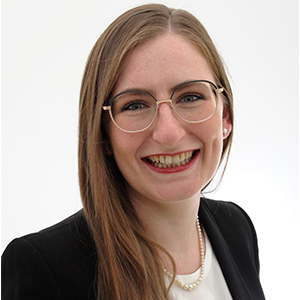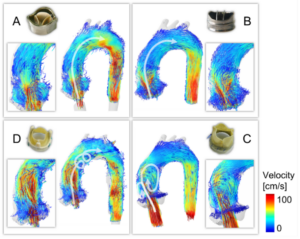
Thekla H. Oechtering, MD, PD Dr med joined the Cardiovascular Imaging section as an assistant professor (tenure) and director of 4D flow MRI in 2025. She has also served as the co-director of Radius since 2024.
She obtained her medical degree from the University of Lübeck in Germany and completed her residency at the University Hospital Schleswig-Holstein. Dr. Oechtering joined the UW Department of Radiology in 2020 as a visiting assistant professor before transitioning to a scientist role in 2023, a Cardiothoracic fellow in 2024, and then as faculty in 2025.
In 2022, Dr. Oechtering was awarded the Albers-Schönberg Medal from the German Röntgen Society, becoming the first woman and youngest recipient to ever receive this award. In 2024, she received her Habilitation, the highest university degree in Germany.
Where are you from?
I am from Germany. I grew up in Leipzig where the Peaceful Revolution started leading to Germany’s reunification in 1989. Leipzig is a famous for its music – from Bach, Wagner and Telemann to nowadays hosting the world’s largest Gothic festival – and has one of Europe’s oldest universities (founded in 1409).

Why did you choose radiology?
I grew up in an academic household where discussing new surgical procedures and the best imaging techniques was normal. My parents are vets active in clinical care and academia and I loved their enthusiasm for their work. My school projects involved imaging my pencil case with x-ray and CT to explain the differences in the technique and to do real and virtual endoscopies of a pepper and my recorder.
In my senior year project, I described the CT anatomy of the nose of brachycephalic dogs like pugs and bulldogs in comparison to a healthy German Shepard. That is how I fell in love with research and imaging. I have continued to do imaging research during med school and wrote my doctoral thesis on postoperative hemodynamics after different ascending aortic aneurysm replacements examined with 4D flow MRI.

What are your professional interests?
I specialize in cardiovascular imaging – as cardiovascular radiologists, we focus on early detection, diagnosis, risk stratification and monitoring treatment for the leading cause of death globally. My favorite modality is MRI as it gives you a wealth of qualitative and quantitative information about organs and hemodynamics without the need for ionizing radiation.
In close collaboration with medical physics, medical engineering, cardiology, and cardiac surgery colleagues, I aim to improve the diagnosis and management of cardiovascular diseases by implementing 4D flow MRI into clinical routine. 4D flow MRI allows us to measure blood flow velocity and direction in the body during a simple MRI exam. My special focus lies on postsurgical aortic hemodynamics and portal hypertension as well as validation of 4D flow MRI.
I am also passionate about teaching and helping others to grow.
Why did you choose to work at UW–Madison?
When my husband Dr. Nikolaos Panagiotopoulos (also a radiologist) and I had the great opportunity to join Dr. Scott Reeder’s research lab as visiting assistant professors in 2020 for two years, we had the clear intention to return to Germany and continue our academic careers there. After two years at UW however, we were convinced by Dr. Scott Reeder that this is the most wonderful place on earth, and it would be worthwhile to repeat all relevant med school exams as well as the board exams to be able to stay here. He was right!
UW has an unmatched environment of excellence in research and clinical services, transdisciplinary collaborations, incredible opportunities and support as well as collegiality. Here, I can pursue my love for research and clinical cardiovascular radiology at the highest level.
What are your hobbies?
I love spending time with my son Johannes who was born here in Madison in 2021 and my husband Nikolaos. We love hanging out with friends (weekend brunches are the best!), going for hikes and visiting family and friends in Germany and Greece.